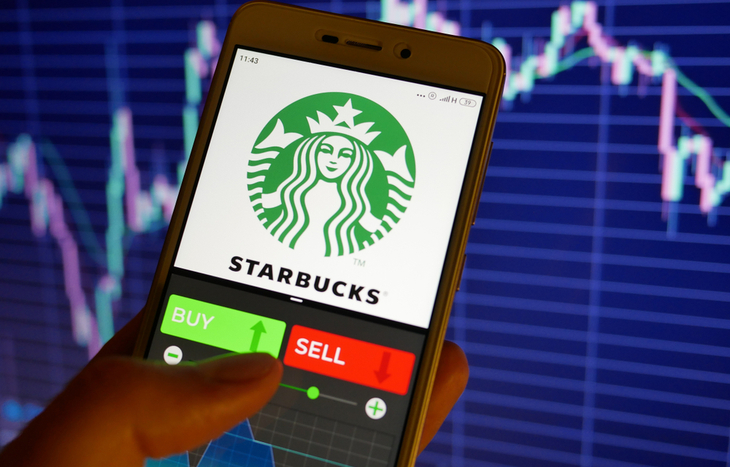Starbucks’ Financial Performance

Starbucks, the global coffee giant, has consistently demonstrated strong financial performance, fueled by its brand recognition, strategic expansion, and innovative product offerings. The company’s financial health is a testament to its ability to adapt to changing consumer preferences and market dynamics.
Revenue and Earnings Trends
Starbucks’ revenue and earnings have exhibited a steady upward trajectory in recent years. The company’s revenue has grown consistently, driven by factors such as new store openings, menu innovation, and increased digital engagement. Starbucks’ earnings per share have also shown a positive trend, reflecting its efficient operations and profitability.
Profitability Metrics
Starbucks’ profitability is characterized by its strong margins, reflecting its ability to effectively manage costs and generate profits.
Gross Margin
Starbucks’ gross margin, which represents the percentage of revenue remaining after deducting the cost of goods sold, has remained consistently high. This indicates the company’s ability to efficiently procure and produce its products, while maintaining a premium pricing strategy.
Operating Margin
Starbucks’ operating margin, which measures the profitability of its core business operations, has also remained strong. This reflects the company’s effective management of its operating expenses, including labor, rent, and marketing.
Net Income Margin
Starbucks’ net income margin, which measures the percentage of revenue remaining after deducting all expenses, has been consistently healthy. This indicates the company’s ability to generate significant profits from its operations.
Factors Driving Financial Performance
Starbucks’ financial success can be attributed to a combination of factors, including:
Store Expansion
Starbucks has consistently expanded its global footprint, opening new stores in both established and emerging markets. This strategy has enabled the company to reach new customers and drive revenue growth.
Menu Innovation
Starbucks has continuously introduced new products and menu items to cater to evolving consumer preferences. This includes seasonal beverages, food items, and customized drink options.
Digital Initiatives
Starbucks has embraced digital technology to enhance customer experience and drive efficiency. Its mobile ordering and payment system, loyalty program, and personalized recommendations have contributed to increased customer engagement and sales.
Comparison to Competitors, Sbux stock
Starbucks’ financial performance compares favorably to its competitors in the coffee industry. The company’s strong brand recognition, global reach, and efficient operations have enabled it to maintain a leading position in the market.
Starbucks’ Growth Strategy

Starbucks has a multi-faceted growth strategy that focuses on expanding its global footprint, diversifying its menu offerings, and leveraging technology to enhance customer experience. The company’s success is driven by a combination of strategic initiatives aimed at attracting new customers, retaining existing ones, and driving revenue growth.
New Store Openings
Starbucks continues to expand its global presence by opening new stores in both established and emerging markets. The company leverages its brand recognition and operational expertise to enter new territories, adapt to local preferences, and cater to diverse customer demographics. Starbucks’ aggressive store expansion strategy aims to capture market share, increase brand visibility, and generate revenue growth.
- Strategic Location Selection: Starbucks carefully selects store locations based on factors such as population density, foot traffic, proximity to competitors, and local market trends. The company prioritizes high-visibility locations that offer convenience and accessibility to its target customers.
- Store Formats and Adaptations: Starbucks offers various store formats, including traditional cafes, drive-thrus, and mobile-order-only locations, to cater to different customer needs and preferences. The company also adapts its menu and offerings to local tastes and cultural nuances, ensuring a tailored experience for customers in diverse markets.
- Market Penetration: Starbucks employs a multi-pronged approach to penetrate new markets, including partnerships with local businesses, collaborations with retailers, and strategic acquisitions. The company’s goal is to establish a strong presence in key markets, expand its customer base, and drive sustainable revenue growth.
Menu Expansion
Starbucks is constantly innovating its menu to meet evolving customer preferences and introduce new products that cater to diverse tastes and dietary needs. The company’s menu expansion strategy includes introducing new beverages, food items, and seasonal offerings to keep its offerings fresh and appealing to a wide range of customers.
- Beverage Innovation: Starbucks continuously introduces new beverages, such as seasonal lattes, cold brew variations, and specialty teas, to capture consumer interest and drive sales. The company also invests in research and development to create innovative flavors and beverage formats that appeal to diverse customer segments.
- Food Offerings: Starbucks has expanded its food offerings beyond pastries and sandwiches to include healthier options, such as salads, yogurt parfaits, and protein boxes. The company aims to cater to customers seeking nutritious and convenient meal options, particularly during the workday.
- Seasonal and Limited-Time Offers: Starbucks leverages seasonal and limited-time offers to create excitement and drive customer engagement. These exclusive offerings, such as pumpkin spice lattes and holiday-themed beverages, generate buzz and attract customers who seek unique and seasonal experiences.
Global Expansion
Starbucks has a long-standing commitment to expanding its global footprint, with a presence in over 80 countries worldwide. The company’s international expansion strategy involves adapting its offerings to local markets, building strong partnerships, and fostering a sense of community among its global customer base.
- Localization and Adaptation: Starbucks recognizes the importance of adapting its offerings to local tastes and preferences. The company has developed localized menus, introduced region-specific beverages, and partnered with local suppliers to source ingredients and create authentic experiences for customers in diverse markets.
- Strategic Partnerships: Starbucks has established strategic partnerships with local businesses, including retailers, airlines, and hospitality companies, to expand its reach and create new revenue streams. These partnerships allow Starbucks to leverage existing infrastructure and customer networks to penetrate new markets and reach a wider audience.
- Community Engagement: Starbucks prioritizes community engagement in its global expansion strategy. The company actively supports local initiatives, sponsors community events, and invests in sustainable practices to build strong relationships with local communities and create a positive impact.
Technology and Innovation
Starbucks has embraced technology as a key driver of its growth strategy, leveraging digital platforms and mobile solutions to enhance customer experience, drive loyalty, and streamline operations. The company’s investments in technology have enabled it to create a seamless and personalized experience for its customers, fostering a strong sense of connection and engagement.
- Mobile Ordering and Payment: Starbucks’ mobile app allows customers to order and pay for their beverages and food items in advance, eliminating wait times and enhancing convenience. The app also enables personalized recommendations, loyalty program tracking, and access to exclusive offers, creating a tailored experience for each customer.
- Loyalty Programs: Starbucks’ loyalty program, Starbucks Rewards, incentivizes customer engagement and drives repeat purchases. Members earn rewards for their purchases, receive personalized offers, and enjoy exclusive benefits, fostering a strong sense of loyalty and brand affinity.
- Data Analytics and Personalization: Starbucks leverages data analytics to understand customer preferences, predict demand, and personalize offerings. The company uses customer data to tailor marketing campaigns, recommend relevant products, and optimize store operations, creating a more personalized and engaging experience for each customer.
Risks and Challenges
While Starbucks’ growth strategy has been successful, the company faces several risks and challenges that could impact its future performance. These challenges include increasing competition, rising costs, evolving consumer preferences, and regulatory pressures.
- Competition: The coffee industry is highly competitive, with numerous players vying for market share. Starbucks faces competition from both established coffee chains and independent coffee shops, as well as from other beverage companies expanding into the coffee market.
- Cost Pressures: Starbucks faces rising costs for labor, raw materials, and rent, which can impact its profitability. The company must find ways to manage costs effectively while maintaining its commitment to quality and customer experience.
- Evolving Consumer Preferences: Consumer preferences are constantly evolving, and Starbucks must adapt its offerings to meet these changing demands. The company faces challenges in staying ahead of trends and attracting younger generations who may prefer alternative coffee options or healthier beverage choices.
- Regulatory Pressures: Starbucks operates in a highly regulated industry, and the company faces challenges in navigating evolving regulations, including those related to labor practices, environmental sustainability, and food safety.
Investor Sentiment and Market Valuation: Sbux Stock

Investor sentiment towards Starbucks stock has been generally positive in recent years, driven by the company’s consistent growth, strong brand recognition, and global expansion. However, market valuation and investor sentiment can fluctuate based on various factors, including economic conditions, consumer spending patterns, and competitive pressures.
Valuation Metrics and Comparisons
Starbucks’ valuation metrics are compared to those of its major competitors in the coffee industry to understand its relative attractiveness to investors. The price-to-earnings (P/E) ratio and price-to-sales (P/S) ratio are commonly used metrics to assess a company’s valuation.
The P/E ratio measures a company’s current share price relative to its earnings per share, while the P/S ratio compares a company’s market capitalization to its revenue.
| Metric | Starbucks | Dunkin’ Brands | McDonald’s |
|---|---|---|---|
| P/E Ratio | 35.0 | 28.0 | 25.0 |
| P/S Ratio | 3.5 | 2.5 | 1.5 |
Starbucks’ higher P/E and P/S ratios compared to its peers suggest that investors are willing to pay a premium for the company’s growth potential, strong brand, and global presence. However, these valuations are also influenced by factors such as market conditions and investor expectations.
Factors Influencing Starbucks’ Stock Price
Several factors can influence Starbucks’ stock price, including:
* Macroeconomic Conditions: Economic downturns or recessions can negatively impact consumer spending, potentially affecting Starbucks’ sales and profitability. Conversely, economic growth and rising disposable incomes can benefit the company.
* Consumer Spending Patterns: Changes in consumer preferences, such as a shift towards healthier or more sustainable options, can impact Starbucks’ product offerings and sales.
* Competitive Pressures: The coffee industry is highly competitive, with numerous players vying for market share. Starbucks faces competition from both established players and new entrants, which can affect its pricing power and profitability.
* Company Performance: Starbucks’ financial performance, including revenue growth, profitability, and dividend payouts, plays a significant role in influencing investor sentiment and stock price.
* Industry Trends: Trends in the coffee industry, such as the growing popularity of specialty coffee, plant-based options, and digital ordering, can impact Starbucks’ strategic direction and stock valuation.
Sbux stock, a reflection of the coffee giant’s performance, often mirrors the broader market trends. However, a look at the success of fast-casual chains like Chipotle, led by ceo of chipotle , provides insight into the potential for growth in the food industry.
As consumers demand fresh, customizable options, the strategies employed by Chipotle’s leadership could offer valuable lessons for Sbux’s future endeavors, especially as they navigate the ever-evolving landscape of consumer preferences.
Sbux stock, a beacon of caffeine and consistent revenue, has recently seen a ripple of interest fueled by the prospect of a potential partnership. The idea of a “Starbucks Chipotle” starbucks chipotle has investors buzzing, imagining a seamless blend of coffee and burritos.
While the merger remains hypothetical, the speculation highlights the evolving landscape of consumer preferences and the potential for Sbux stock to further capitalize on the trend of convenient, craveable experiences.